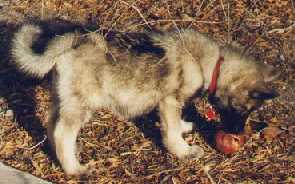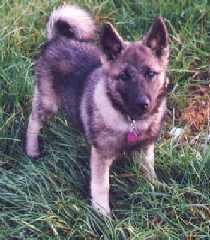 Cinder's Story
Cinder's Story
 Cinder's Story
Cinder's Story |
|
|
|
In February of 2000 I was contacted by a woman in
Florida about a 4-month old elkhound puppy who was seized in a pet shop closure ( I
am a coordinator for a national elkhound rescue group - John Nelsen Moosedog
Rescue Fund). The puppy was diagnosed with Type 1 diabetes and they
were looking for foster care and help. What she did not know was that I
am a registered nurse, registered dietitian, and former diabetic educator and
former vet tech. As you can see from this picture  , Cinder was very ill.
She was
bloated , extremely underweight (about 7 pounds), and very pathetic looking. But she was
totally sweet and despite being on the edge of death, she loved people.
Cinder and her initial rescuer, Anita, flew out to my home in New Mexico on
February 25, 2000. Despite having been on insulin for two weeks she was running 500 + glucoses and large urinary ketones. What
the vet had not realized was that her insulin resistance was due to a lack of
chromium. The clue was that one day before flying out her they placed her on chromium
picolinate- 1
tablet at night - and the morning after receiving chromium she stopped
spilling ketones. I gave her chromium with her next meal and insulin (NPH and
Regular) and suddenly her blood glucose began to normalize. , Cinder was very ill.
She was
bloated , extremely underweight (about 7 pounds), and very pathetic looking. But she was
totally sweet and despite being on the edge of death, she loved people.
Cinder and her initial rescuer, Anita, flew out to my home in New Mexico on
February 25, 2000. Despite having been on insulin for two weeks she was running 500 + glucoses and large urinary ketones. What
the vet had not realized was that her insulin resistance was due to a lack of
chromium. The clue was that one day before flying out her they placed her on chromium
picolinate- 1
tablet at night - and the morning after receiving chromium she stopped
spilling ketones. I gave her chromium with her next meal and insulin (NPH and
Regular) and suddenly her blood glucose began to normalize. I started her on four meals a day. I used a home-prepared diet because the glycemic index of all standard dog foods is too high - mostly because of the form it comes in - so finely ground, etc. I began testing her BG four times a day. I read all the techniques, but instead developed my own. I keep her nails very short by using a nail grinder and grinding close to but not into the quick. I then use a lancet to pick the quick and get a drop of blood - (sometimes several drops if I went too deep). The advantage to this technique is that I have 18 sites and generally use one foot a week and rotate nails daily. She really does not object to the tests as she knows that as soon as she is stuck she will get to eat. Once her diabetes was under control, she began to grow very rapidly - an average of 2 pounds a week. At 8 months she weighed 25 pounds. She was spayed in July 2000. Following surgery - her blood sugar was up and down for about 2 weeks but she healed well and blood sugar fluctuations stabilized 2 weeks after surgery. Cinder  is
now a little over 13 months. Her weight is about 30 pounds. She is on a feeding
schedule of 6am - noon - 6 pm an 11pm. Morning and evening are meals and noon
and bedtime snacks. I use a diet composed of cooked barley or millet combined
with grated veggies, oil, egg yolks, cottage cheese (sometimes) and ground beef
or turkey. This diet is supplemented with vitamins and minerals. She gets raw
beef ribs once a week for her teeth. Basically she gets ¾ cup for a meal and
1/3 cup for the snack. She is on very low doses of NPH. 3 units with meals and 2
units with snacks. If her blood sugar is above 250 when tested I add ½ unit of
R. Her blood glucose levels are pretty consistently between 65 and 150. is
now a little over 13 months. Her weight is about 30 pounds. She is on a feeding
schedule of 6am - noon - 6 pm an 11pm. Morning and evening are meals and noon
and bedtime snacks. I use a diet composed of cooked barley or millet combined
with grated veggies, oil, egg yolks, cottage cheese (sometimes) and ground beef
or turkey. This diet is supplemented with vitamins and minerals. She gets raw
beef ribs once a week for her teeth. Basically she gets ¾ cup for a meal and
1/3 cup for the snack. She is on very low doses of NPH. 3 units with meals and 2
units with snacks. If her blood sugar is above 250 when tested I add ½ unit of
R. Her blood glucose levels are pretty consistently between 65 and 150.She continues to receive Chromium supplementation. 200 mcg with meals and 100 mcg with snacks. If by chance I forget the chromium her blood sugar will be up to 350 within 4 hours. She had an eye exam in July after she was spayed. The ophthamologist said she had some areas of cataract formation but they appeared to not be related to her diabetes as they were pericapsular. She will return in January for a 6 month follow-up. She completed basic obedience classes in October and will begin Pet Therapy work in the coming months. I have arranged for her to visit a local kindergarten class as there are two children with juvenile diabetes in the class. This will give them a chance to meet another diabetic leading a ‘normal’ life. I believe by sharing information, we can teach willing owners to manage their diabetic pets much better than most are now being managed. -- Contributed by Majorie (Majie) Powey, RN RD (former Vet Tech) Coordinator John Nelsen Moosedog Rescue Fund
Contributed June 2000 |